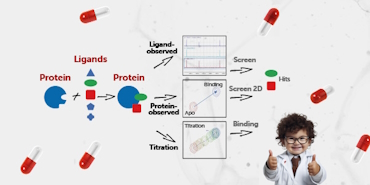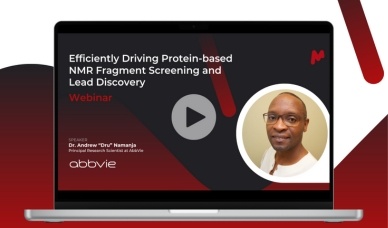Efficiently driving protein-based fragment screening and lead discovery using two-dimensional NMR
| Title: | Efficiently driving protein-based fragment screening and lead discovery using two-dimensional NMR |
| Authors: | Chen Peng, Andrew T. Namanja, Eva Munoz, Haihong Wu, Thomas E. Frederick, Mitcheell Maestre-Martinez, Isaac Iglesias Fernandez, Qi Sun, Carlos Cobas, Chaohong Sun & Andrew M. Petros |
| Date: | Epub 2022 Dec 13, |
| Reference: | J Biomol NMR. 2023 Apr |
| DOI: | 10.1007/s10858-022-00410-3 |
| Download link: | https://pubmed.ncbi.nlm.nih.gov/36512150/ |
ABSTRACT
Fragment-based drug discovery (FBDD) and validation of small molecule binders using NMR spectroscopy is an established and widely used method in the early stages of drug discovery. Starting from a library of small compounds, ligand- or protein-observed NMR methods are employed to detect binders, typically weak, that become the starting points for structure-activity relationships (SAR) by NMR. Unlike the more frequently used ligand-observed 1D NMR techniques, protein-observed 2D 1H-15N or 1H-13C heteronuclear correlation (HSQC or HMQC) methods offer insights that include the mechanism of ligand engagement on the target and direct binding affinity measurements in addition to routine screening. We hereby present the development of a set of software tools within the MestReNova (Mnova) package for analyzing 2D NMR for FBDD and hit validation purposes. The package covers three main tasks: (1) unsupervised profiling of raw data to identify outlier data points to exclude in subsequent analyses; (2) batch processing of single-point spectra to identify and rank binders based on chemical shift perturbations or spectral peak intensity changes; and (3) batch processing of multiple titration series to derive binding affinities (KD) by tracing the changes in peak locations or measuring global spectral changes. Toward this end, we implemented and evaluated a set of algorithms for automated peak tracing, spectral binning, and variance analysis by PCA, and a new tool for spectral data intensity comparison using ECHOS. The accuracy and speed of the tools are demonstrated on 2D NMR binding data collected on ligands used in the development of potential inhibitors of the anti-apoptotic MCL-1 protein.



